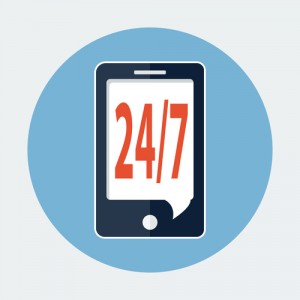Which intuitive retail technology apps are boosting sales?
 By 2016, 75% of the UK population will be using a smartphone, opening the door to even more digital opportunities for both customer and retailer.
By 2016, 75% of the UK population will be using a smartphone, opening the door to even more digital opportunities for both customer and retailer.
With mobile technology, consumers have a 24/7/365 shopping window where they can research, locate and purchase from anywhere. The average mobile user spends 127 minutes per day on apps, Tech Crunch reports which is challenging television viewing figures of 168 minutes. Yet mobile budgets aren’t nearly as high as TV. Why?
Retailers need to be aware that m-shopping isn’t solely another route to take the consumer from browse to buy. In the words of Chris Brook-Carter, editor-in-chief of Retail Week, “From mobile commerce to social media, augmented reality to smart television, new technologies and their effect on consumer dynamics are at once an opportunity to open new routes to market and a daunting challenge retailers need to adapt to.”
Customers are quick to adopt technology-based tools that bring relevance and entertainment to their lives, and some retailers are recognising the mobile’s talent for enhancing customer experience, adding ease and convenience, but also fun and games. The mobile app is certainly making waves in this field; let’s take a look:
- Tesco – Noting that busy female online shoppers have a tendency to use their mobile in bite size moments, Tesco has designed and app that stores the data from these brief encounters and saves it to be accessed later when the customer is ready to make a full shop. For example, a customer books a delivery time slot and puts a couple of things in the basket, but then doesn’t complete the session. The app gives the user the opportunity to re-use that data and find it in their account back at home.
- Tapestry – Imagine having an interactive scrapbook of store items that that you like and may potentially buy on your phone. This is in effect what Tapestry is; the teaser app allows the user to scan barcodes or tap NFC tags as they browse a store, catalogue or ad and keep a record of all clothes and shoes, for example, that they want. The app places focus on the potential for purchase rather than immediate spend, allowing consumers to dwell on/research the item in question but also usefully see if a price reduction takes place.
- Snap Fashion – Where’s that top from? May become a question of the past now that this app is on the scene. Users can use it to trace a piece of clothing that they have seen on a person, on a website, in a catalogue or in store. They ‘snap’ the item in question and the app uses image recognition to direct them to the item online as well as suggest similar versions. Clearly marked as a winning app, Snap Fashion now has a database of over 100 major retailers including Topshop, Jigsaw, Uniqlo, Warehouse, LK Bennett and Kurt Geiger, in addition to e-tailers Net-A-Porter, Asos, my-wardrobe, stylebop and farfetch, and department stores such as Harrods, Selfridges, Liberty and House of Fraser.
- Blippar – Both Heinz Ketchup and Marmite have worked with this UK augmented reality company to create recipe books that appear when a product is scanned at the till point, giving consumers ideas and inspiration on their receipt.
- iBalloon – Great fun for promotions this app enables shoppers to find discounts and offers. When they open the app, users see their environment through what looks like a regular camera screen, but at certain locations they see an augmented reality balloon. By tapping on the balloons, discounts and offers are released.
- Open4Sale – Customers who are shopping online will now be able to instant message or video chat with sales assistants in the physical store. The app aims to provide good old-fashioned customer service provided in a technologically advanced way, building an emotional rather than solely transactional relationships. Shoppers can view and select assistants and talk to them if there light is green, once connected the assistant can see the shopper’s purchase history and tailor their advice accordingly. They can even drag and drop suggested items into the app shopping basket where customers can review them in real time and go on to make a purchase online.
Chris Brook-Carter, editor-in-chief of Retail Week, has a few points for retailers that are on the edge of investing in a mobile app to consider:
- When and where are you starting conversations with your existing and potential customers?
- Are you interacting with the 77% of TV viewers who use a second screen while watching TV?
- Do you give customers targeted, appropriate opportunities to share the experiences they
- How can you track your customers’ journeys, before, during and after purchase?


No comments yet.